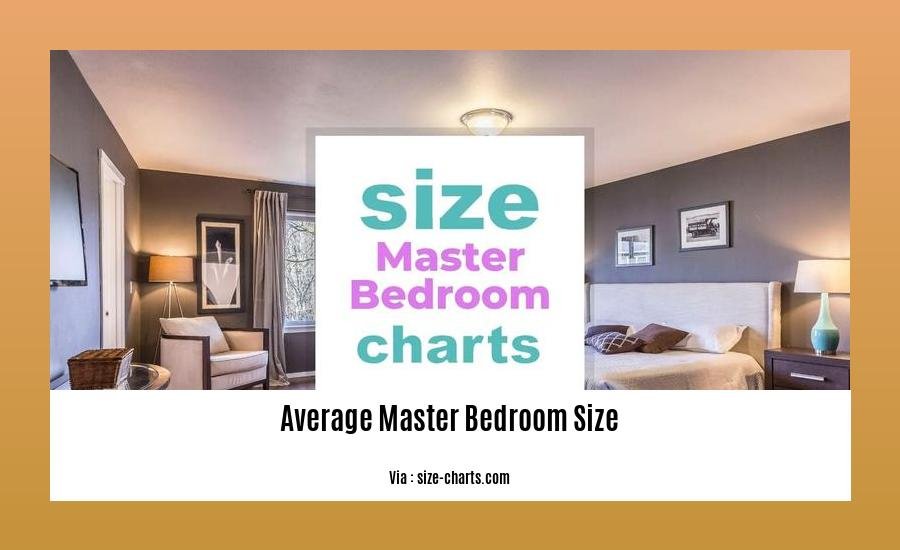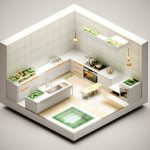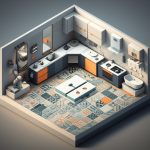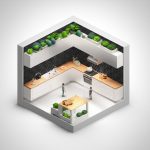[- What is the Average Master Bedroom Size? A Comprehensive Guide for Homeowners] – Figuring out the average master bedroom size can be a daunting task, especially for first-time homeowners and those seeking information on homeownership. This comprehensive guide will break down the factors that determine master bedroom space and provide an in-depth look at the average measurements found in homes across the country.
Key Takeaways:
-
The average master bedroom size depends on the size of the house.
-
For houses between 2,000 and 2,500 square feet, the typical master bedroom size ranges from 250 to 310 square feet.
-
In a 2,000-square-foot house, a small master bedroom is usually around 224 square feet, while a large master bedroom can be up to 350 square feet.
-
For houses between 2,500 and 2,999 square feet, a large master bedroom typically measures between 300 and 350 square feet.
-
An extra-large master bedroom is usually 43 percent larger than the other rooms in the house, and can range from 350 to 400 square feet.
Average Master Bedroom Size
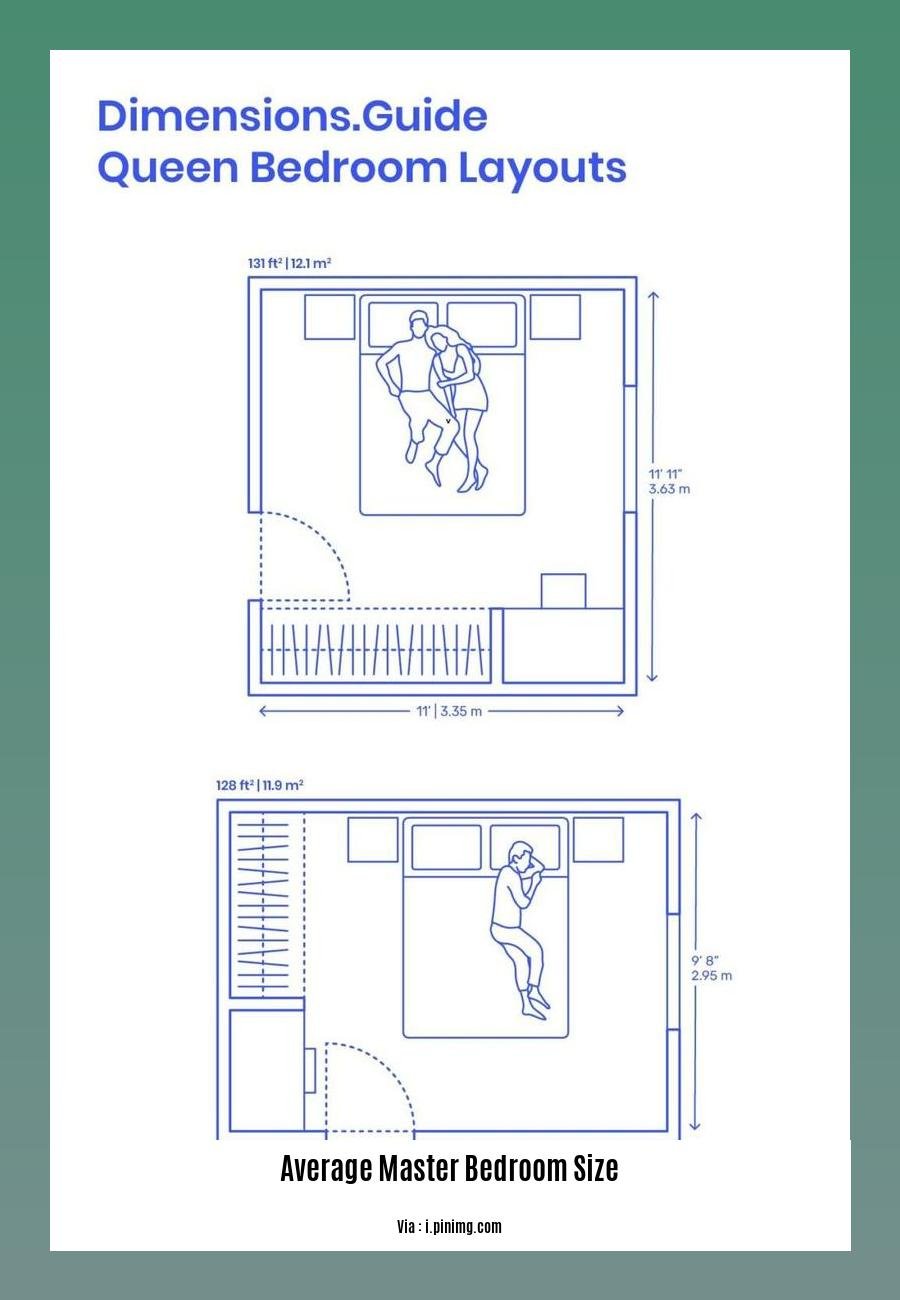
So, you’re thinking of building or remodeling a home and wondering about the average master bedroom size. Well, you’re in the right place! In this guide, we’ll delve into the world of master bedroom dimensions, providing you with all the essential insights you need to create a tranquil and functional sleeping sanctuary.
Factors Influencing Master Bedroom Size
Before we dive into specific measurements, it’s essential to understand the factors that influence the average master bedroom size. These include:
-
Overall House Size: Generally, the larger the house, the bigger the master bedroom. For homes between 2,000 and 2,500 square feet, the average master bedroom size ranges from 250 to 310 square feet.
-
Type of Home: Single-family homes tend to have larger master bedrooms compared to apartments or townhouses.
-
Age of the Home: Older homes often have smaller master bedrooms due to different architectural styles and space constraints.
-
Location: Regional preferences and cultural norms can impact master bedroom sizes. For example, homes in rural areas may have larger master bedrooms than those in urban areas.
Common Master Bedroom Sizes
Now, let’s explore some common master bedroom sizes based on different house sizes:
| House Size (Square Feet) | Average Master Bedroom Size (Square Feet) |
|---|---|
| 2,000 – 2,500 | 250 – 310 |
| 2,500 – 2,999 | 300 – 350 |
| 3,000 – 3,999 | 350 – 400 |
| 4,000+ | 400+ |
Small, Large, and Extra-Large Master Bedrooms
Within these average master bedroom sizes, you may encounter variations that fall into three categories:
-
Small Master Bedrooms: Typically found in smaller homes, these bedrooms measure around 224 square feet (for a 2,000 square foot house).
-
Large Master Bedrooms: Usually 14 percent larger than the rest of the rooms in the house, these bedrooms range between 300 and 350 square feet (for houses measuring 2,500 to 2,999 square feet).
-
Extra-Large Master Bedrooms: These spacious retreats are typically 43 percent larger than the other rooms in the house and measure around 350 to 400 square feet.
Conclusion
Ultimately, the average master bedroom size depends on various factors, including the overall house size, type of home, age of the home, and location. By understanding these factors and considering your own needs and preferences, you can create a master bedroom that offers both comfort and functionality.
- Art Studio Design Ideas for Small Spaces: From cozy corners to compact creations, discover the art of making the most of limited square footage.
- Add Freshness with Artificial Plants in Living Room Ideas: Explore stunning artificial plant arrangements that bring a touch of greenery and vitality to your living space.
- Average Hotel Room Size: Unveiling the Standards: Get insights into the typical dimensions and layouts of hotel rooms worldwide, ensuring a comfortable and enjoyable stay.
- Uncover the Average Monthly Cost of Retirement Home in Ontario: Planning for retirement? Explore the financial implications of living in a retirement home in Ontario and make informed decisions.
Pros and cons of large and small master bedrooms
Hey homeowners! Let’s chat master bedrooms! The heart of your private haven, they come in all shapes and sizes. Let’s balance the scales and explore the pros and cons of large and small master bedrooms.
Key Takeaways:
- Large Master Bedrooms:
- Pros: Spaciousness, luxury, various layout options.
-
Cons: Higher cost, potential for feeling empty, energy inefficiency.
-
Small Master Bedrooms:
- Pros: Cozy, lower cost, energy efficiency.
-
Cons: Limited space, fewer layout options, potential for feeling cramped.
-
Making the Right Choice:
- Consider personal needs, lifestyle, and budget.
-
Prioritize comfort, functionality, and personal preferences.
-
Choose the master bedroom layout that aligns with your vision of comfort and functionality.
Now, let’s delve into the details, shall we?
Pros of Large Master Bedrooms:
-
Spaciousness: Spread out, breathe deep, and revel in the luxurious expanse. Large master bedrooms offer ample space for a plush bed, cozy sitting area, and even a home office nook.
-
Layout Options: When space is on your side, layout possibilities dance before you. Create distinct zones for sleeping, lounging, and dressing, tailored to your unique lifestyle.
-
Visual Appeal: A large and well-designed master bedroom can elevate the entire home’s aesthetic, becoming a statement of refined taste and comfort.
Cons of Large Master Bedrooms:
-
Costly: Size comes with a price tag. Building and maintaining a large master bedroom can strain your budget.
-
Emptiness: Sometimes, more space can lead to a sense of emptiness. Furnishing and decorating a large master bedroom can be a challenge, especially if you prefer a cozy atmosphere.
-
Energy Inefficiency: Heating and cooling a large master bedroom can be energy-intensive, leading to higher utility bills.
Pros of Small Master Bedrooms:
-
Cozy Charm: When space is limited, coziness takes center stage. Small master bedrooms exude a warm and intimate feel, perfect for creating a peaceful retreat.
-
Affordability: Building and maintaining a small master bedroom is generally more cost-effective, leaving more room in your budget for other home upgrades.
-
Energy Efficiency: Smaller spaces are easier to heat and cool, resulting in lower energy consumption and reduced utility bills.
Cons of Small Master Bedrooms:
-
Limited Space: With less square footage, you’ll have to be mindful of furniture placement and storage solutions. Maximizing space and minimizing clutter become essential.
-
Fewer Layout Options: Space constraints limit layout possibilities. You may have to compromise on your ideal design to accommodate essential furniture and maintain functionality.
-
Cramped Feeling: If not thoughtfully designed, a small master bedroom can feel confining and uncomfortable.
Ultimately, the choice between a large and small master bedroom is a personal one, guided by your needs, lifestyle, and budget. Carefully consider the pros and cons of each option, prioritize comfort and functionality, and create the master bedroom that perfectly reflects your vision of home.
Sources:
Master Bedroom Dimensions & Layout Guidelines (with Pictures)
The Truth About Average Master Bedroom Size
Design Ideas for Master Bedrooms
Hey there, interior enthusiasts and fellow homeowners! In today’s design guide, we’ll delve into the realm of master bedroom design, unlocking the secrets of creating a space that exudes comfort, functionality, and personal style. Let’s dive in!
Key Takeaways:
-
Size Matters:
Consider the dimensions of your master bedroom to ensure it accommodates essential furniture and allows for comfortable movement. -
Layout Magic:
Plan the master bedroom layout strategically, prioritizing the placement of furniture, windows, and electrical outlets for optimal functionality. -
Comfort Zone:
Create a cozy and inviting atmosphere with plush bedding, soft rugs, and calming color palettes. -
Storage Solutions:
Incorporate ample closet space or utilize creative storage ideas to keep the bedroom clutter-free. -
Natural Charm:
Maximize natural light by incorporating large windows and sheer curtains, promoting a sense of airiness and connection to the outdoors. -
Personal Sanctuary:
Infuse your master bedroom with personal touches, such as artwork, family photos, and cherished mementos, to create a space that truly reflects your essence.
Design and Decor Tips:
- Visual Symphony:
-
Create a harmonious visual flow by selecting a cohesive color scheme and incorporating complementary patterns and textures.
-
Furniture Finesse:
-
Choose furniture pieces that not only complement the bedroom’s overall design but also serve your functional needs.
-
Lighting Artistry:
-
Layer different lighting sources, combining ambient, task, and accent lighting to create a warm and inviting ambiance.
-
Textile Symphony:
-
Play with different fabrics and textures to add depth and visual interest to the bedroom, from plush rugs to flowing curtains.
-
Accessorize with Intention:
- Elevate the design with well-chosen accessories, such as decorative pillows, throws, and artwork, that reflect your personality and style.
Remember: Your master bedroom should reflect your unique taste and preferences. Whether you favor a minimalist aesthetic, a classic look, or a touch of bohemian flair, let your personal style shine through!
Recommended URL Sources:
- Master Bedroom Dimensions & Layout Guidelines (with Pictures)
- The Truth About Average Master Bedroom Size
Trends in master bedroom size
Hey there, home enthusiasts! Today, we’re diving into the world of master bedrooms and exploring the ever-changing trends in their sizes. From cozy nooks to expansive retreats, let’s uncover the factors shaping these spaces and how you can create the perfect sanctuary for rest and relaxation.
Key Takeaways:
- Standard Master Bedroom Size: Typically ranges between 15 x 20 feet (300 to 350 square feet) in houses measuring 2,500 to 2,999 square feet.
- Size Variations: Master bedroom dimensions vary based on overall house size, type of home, age, and regional preferences.
- Small Master Bedrooms: Common in houses measuring 2,000 square feet, with dimensions around 14 x 16 feet (224 square feet).
- Large and Extra-Large Master Bedrooms: Can be 14% and 43% larger than other rooms, respectively, and may include features like sitting areas and en-suite bathrooms.
- Layout Considerations: Ensure adequate space for essential furniture, ample closet space, natural light and ventilation, and optimal placement of electrical outlets and light fixtures.
Breaking Down the Trends
Smaller Homes, Smaller Master Bedrooms: In recent years, the trend towards smaller homes has led to a decrease in average master bedroom sizes. Builders are prioritizing efficient use of space, creating compact yet functional master bedrooms that pack a punch in terms of comfort and style.
Luxurious Retreats: On the other hand, luxury homes are embracing expansive master bedrooms that serve as private havens. These oversized sanctuaries often include sitting areas, en-suite bathrooms with spa-like features, and walk-in closets fit for fashion enthusiasts.
Multifunctional Spaces: Master bedrooms are no longer just for sleeping. They’re evolving into multifunctional spaces that cater to a variety of activities, from work to relaxation. Incorporating designated areas for a home office, reading nook, or meditation corner is becoming increasingly popular.
Smart Storage Solutions: With the rising cost of real estate, homeowners are seeking clever ways to maximize storage space in their master bedrooms. Built-in wardrobes, under-bed storage, and innovative closet systems are all the rage, helping to keep clutter at bay and create a serene environment.
Sustainable Design: Sustainability is making its way into master bedroom design as well. Eco-friendly materials, energy-efficient lighting, and natural ventilation are becoming more common, creating healthier and more environmentally conscious spaces.
Creating Your Dream Master Bedroom
No matter the size of your home, you can create a master bedroom that’s both comfortable and stylish. Here are a few tips:
- Start with a Well-Defined Layout: Plan the layout carefully to ensure there’s enough space for essential furniture and movement. Consider the placement of windows, doors, and electrical outlets to optimize functionality.
- Choose Multifunctional Furniture: Invest in furniture pieces that serve multiple purposes, such as a bed with built-in storage drawers or a nightstand with a built-in charging station.
- Maximize Natural Light: Incorporate large windows or skylights to let in ample natural light, creating a bright and airy atmosphere.
- Add Personal Touches: Make your master bedroom a reflection of your personality and style by adding artwork, plants, and other decorative elements that speak to you.
Conclusion
The trends in master bedroom size reflect the evolving needs and preferences of homeowners. Whether you’re looking for a cozy retreat or a luxurious sanctuary, careful planning and thoughtful design can transform your master bedroom into a space you’ll love spending time in.
Sources:
- Master Bedroom Dimensions & Layout Guidelines (with Pictures)
- The Truth About Average Master Bedroom Size
FAQ
Q1: What is the typical size of a master bedroom?
A1: The typical size of a master bedroom can vary based on the overall size of the house. For houses measuring 2,500 to 2,999 square feet, the average master bedroom size is 15 x 20 feet or 300 to 350 square feet. However, the size can range from 224 square feet for small master bedrooms to over 400 square feet for extra-large master bedrooms.
Q2: How do you determine the size of a master bedroom?
A2: To determine the size of a master bedroom, measure the length and width of the room in feet or meters. Multiply the length by the width to calculate the area in square feet or square meters. For example, a master bedroom measuring 15 feet by 20 feet would have an area of 300 square feet.
Q3: What are the standard dimensions for a master bedroom?
A3: Standard dimensions for a master bedroom vary depending on the overall house size. For houses measuring 2,500 to 2,999 square feet, common master bedroom dimensions are 15 x 20 feet or 300 to 350 square feet. Smaller master bedrooms in houses measuring 2,000 square feet may be around 14 x 16 feet or 224 square feet, while larger master bedrooms can measure up to 18 x 20 feet or 18 x 22 feet.
Q4: What factors influence the size of a master bedroom?
A4: The size of a master bedroom is influenced by several factors, including the overall size of the house, the number of bedrooms and bathrooms in the house, and the architectural style of the house. Larger houses tend to have larger master bedrooms, and houses with more bedrooms and bathrooms may have smaller master bedrooms to accommodate the additional spaces.
Q5: What are some considerations for designing a master bedroom layout?
A5: When designing a master bedroom layout, it is important to consider the size and shape of the room, as well as the desired furniture and features. The layout should ensure that there is enough space for a comfortable bed, nightstands, a dresser, and other essential furniture. Additionally, consider incorporating ample closet space for storage, windows for natural light and ventilation, and electrical outlets and light fixtures for optimal functionality.
– Interior Design Ideas & Space Management for an Average Master Bedroom Size
Discover a world of design possibilities for your master bedroom with our comprehensive guide to interior design ideas and space management for an average master bedroom size. Get expert advice on maximizing comfort, functionality, and style within the confines of your space. Whether you’re seeking a tranquil retreat or a vibrant haven, our insights and practical solutions will help you transform your master bedroom into a space that reflects your unique personality and lifestyle. Explore creative space planning techniques, furniture selection tips, and color theories that will turn your average-sized master bedroom into an extraordinary oasis of comfort and style.
Key Takeaways:
-
Master Bedroom Size:
- The average master bedroom size varies with the overall house size.
- For houses between 2,000 to 2,500 square feet, typical dimensions range from 14′ x 18′ to 15′ x 20′, providing an area of 250 to 310 square feet.
- A suitable master bedroom should measure at least 15 feet on each side.
- Extra-large master bedrooms are generally 43% bigger than other rooms in the house.
- Large master bedrooms tend to be 14% larger than the rest of the rooms in the house.
-
Space Planning and Furniture Selection:
- Understanding scale and spatial relationships is crucial to ensure each element complements the space, creating a harmonious and inviting master bedroom retreat.
- Furniture selection should consider the size of the room and the desired layout to maximize comfort and functionality.
-
Color Theory:
- Color plays a significant role in creating the desired ambiance in a master bedroom.
- Selecting a color scheme that aligns with the homeowner’s preferences and the overall design style is essential for achieving a cohesive and aesthetically pleasing look.
-
Functional and Aesthetic Design:
- The goal is to create a master bedroom that not only looks beautiful but also caters to the practical needs and preferences of the homeowners.
- Combining these aspects ensures a master bedroom that is both stylish and functional.
Average Master Bedroom Size
Is your average master bedroom size feeling cramped and uninviting? Don’t worry, you’re not alone. Many homeowners struggle to create a comfortable and stylish master bedroom within the confines of a standard-sized space. But with careful planning and a few clever tricks, you can transform your average master bedroom into a luxurious retreat.
What is the Average Master Bedroom Size?
There is no one-size-fits-all answer to this question, as the average master bedroom size can vary depending on the overall size of the house. However, according to industry standards, the typical dimensions for master bedrooms in houses measuring 2,000 to 2,500 square feet are:
- 14 x 18 feet
- 15 x 18 feet
- 14 x 20 feet
- 15 x 20 feet
This translates to approximately 250 to 310 square feet of space.
How to Make the Most of Your Average Master Bedroom Size
- Maximize Vertical Space:
Maximize your vertical space by adding floating shelves, hanging baskets, and wall-mounted storage solutions. This will free up floor space and make your bedroom feel more spacious.
- Choose Multi-Functional Furniture:
Invest in furniture that serves multiple functions. For example, an ottoman with built-in storage or a bed with built-in drawers can help you save space and keep your belongings organized.
- Use Light Colors:
Light colors reflect light and make a room feel larger. Paint your walls in a light, neutral color and choose light-colored bedding and curtains.
- Add Mirrors:
Mirrors can make a room feel larger by reflecting light and creating the illusion of more space. Hang a large mirror on one of your bedroom walls to make it feel more spacious.
- Add Plants:
Plants can add life and color to your bedroom. They can also help to purify the air and create a more relaxing atmosphere.
- Choose the Right Furniture:
Choose furniture that is proportionate to the size of your bedroom. Oversized furniture can make a small bedroom feel even smaller.
- Keep it Clutter-Free:
Keep your bedroom free of clutter to make it feel more spacious and inviting. Donate or sell anything you don’t need or use.
By following these tips, you can create a beautiful and functional master bedroom, even if you have an average master bedroom size.
-
Looking to maximize creativity in a limited space? Discover our art studio design ideas for small spaces and turn your compact area into an inspiring haven.
-
Breathe life into your living room with our curated guide to artificial plants in living room ideas. Add a touch of nature’s beauty without the hassle of maintenance.
-
Curious about the typical dimensions of a hotel room? Check out our informative piece on average hotel room size and get the inside scoop on industry standards.
-
Planning for retirement? Explore our comprehensive analysis of the average monthly cost of retirement home in Ontario and make informed decisions about your future.
Design Considerations for Average-Sized Master Bedrooms: Maximizing Space and Functionality
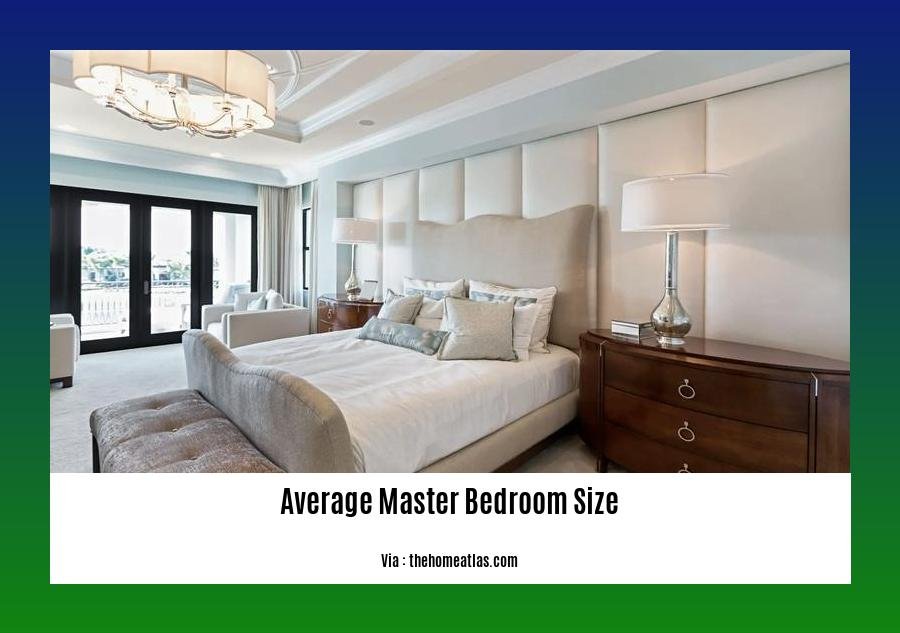
Key Takeaways:
-
The typical master bedroom in the U.S. measures around 309 square feet, offering ample room for relaxation and comfort.
-
Smaller homes may have master suites around 231 square feet, while larger homes can boast master bedrooms up to 411 square feet.
-
A well-designed master bedroom should prioritize functionality, personal preferences, and the intended use of the space.
-
Strategic space planning, furniture selection, and color choices can significantly enhance the functionality and aesthetics of an average-sized master bedroom.
-
Using built-in storage solutions, choosing proportional furniture, and incorporating personal style can create a harmonious and inviting retreat.
When designing an average-sized master bedroom, it’s essential to consider the following:
1. Efficient Space Planning
-
Begin by measuring the room accurately to create a precise floor plan.
-
Position the bed strategically to avoid blocking windows or doorways.
-
Allocate space for essential furniture, such as nightstands, a dresser, and a seating area if possible.
-
Utilize vertical space with floating shelves, hanging racks, and wall-mounted storage solutions.
2. Furniture Selection
-
Opt for furniture that is proportional to the room’s size to maintain a sense of balance and harmony.
-
Choose multifunctional pieces, like ottomans with built-in storage or beds with drawers for added functionality.
-
Select furniture with clean lines and simple designs to create a minimalist and airy look.
-
Incorporate mirrors to reflect light and create the illusion of a larger space.
3. Color Palette and Lighting
-
Use light and neutral colors on walls, bedding, and curtains to make the room feel larger and brighter.
-
Introduce pops of color through accent pillows, throws, or artwork to add visual interest.
-
Layer lighting with overhead fixtures, bedside lamps, and accent lights to create a warm and inviting ambiance.
-
Natural light is crucial; maximize it with sheer curtains or blinds that allow sunlight to filter in.
4. Personal Touches
-
Incorporate personal touches, such as framed photos, artwork, or decorative items, to create a cozy and lived-in feel.
-
Add plants to add life, color, and improve air quality.
-
Use rugs to define different areas of the room and add warmth and texture.
-
Keep the bedroom clutter-free to create a sense of spaciousness and tranquility.
By thoughtfully considering these design elements, you can transform an average-sized master bedroom into a comfortable, functional, and stylish sanctuary that meets your needs and enhances your daily living experience.
Relevant URL Sources:
1. Average Master Bedroom Size (Standard Dimensions) in 2023
2. Master Bedroom Dimensions & Layout Guidelines (with Photos)
Space-Saving Solutions for Smaller Master Bedrooms: Creative Storage Ideas and Layout Strategies
Hey there, folks! Let’s delve into the realm of Space-Saving Solutions for Smaller Master Bedrooms: Creative Storage Ideas and Layout Strategies. If you’re struggling to make the most of your limited master bedroom space, fret not; we’ve got some clever tricks up our sleeves to help you transform it into an oasis of comfort and style.
Key Takeaways:
- Unleash the power of vertical space with floating shelves, wall-mounted organizers, and hanging baskets.
- Transform your bed into a storage haven with built-in drawers, under-bed containers, and headboard shelves.
- Utilize multi-functional furniture like ottoman-storage combos and convertible sofa beds to maximize functionality.
- Embrace the beauty of light colors and reflective surfaces to create the illusion of a larger space.
- Elevate your storage game with clever utilization of corners, such as corner desks and shelves.
For those with smaller master bedrooms, space optimization is key. Begin by taming the clutter. Declutter and get rid of anything you don’t use. This not only frees up space but also creates a more peaceful environment. Next, think vertical! Floating shelves, hanging baskets, and wall-mounted organizers can work wonders for storing books, décor, and other knick-knacks without taking up precious floor space.
Speaking of beds, they can be so much more than just a place to rest your head. Look for beds with built-in drawers or under-bed storage containers. You can also add headboard shelves for additional storage and display space. If you’re short on space, consider a Murphy bed that folds away during the day, revealing a workspace or sitting area.
Multi-functional furniture is your ally in space-challenged bedrooms. Opt for an ottoman with built-in storage or a convertible sofa bed that doubles as a seating area during the day and a cozy bed at night. These clever pieces pack multiple functions into one, maximizing functionality without overcrowding the room.
Light colors are your friend when it comes to making a small space feel larger. They reflect light, creating the illusion of more space. Pair light-colored walls with light-colored bedding, curtains, and furniture for a cohesive and airy look. To further enhance the sense of spaciousness, incorporate mirrors into your décor. Mirrors reflect light and visually expand the room, making it feel larger and brighter.
Finally, don’t forget about the corners! Corners are often overlooked, but they can be valuable real estate in a small bedroom. Consider adding a corner desk, corner shelves, or even a cozy reading nook in an unused corner. These clever solutions can add both storage and functionality without sacrificing valuable floor space.
With a little creativity and these space-saving solutions, you can transform your smaller master bedroom into a haven of comfort, style, and functionality. Remember, it’s all about maximizing vertical space, utilizing multi-functional furniture, and embracing the beauty of light colors and reflective surfaces. Happy decorating!
Relevant URL Sources:
- Small Bedroom Storage Ideas: 20 Clever Ways to Maximize Space
- Small master bedroom ideas: 13 restful schemes – Homes & Gardens
Key Elements of a Well-Designed Master Bedroom: Furniture Arrangement, Color Schemes, and Lighting Techniques
Decorating your master bedroom involves more than just aesthetics. It’s about creating a personal oasis where you can relax, recharge, and find solace. Let’s explore essential elements that contribute to a well-designed master bedroom, focusing on furniture arrangement, color schemes, and lighting techniques.
Key Takeaways:
-
A well-designed master bedroom strikes a balance between comfort and functionality.
-
Thoughtful furniture arrangement optimizes space, improves traffic flow, and defines areas for sleep, relaxation, and dressing.
-
A calming color palette sets the mood and ambience, promoting relaxation and tranquility.
-
Proper lighting creates layers of illumination, accommodating various activities and enhancing the overall ambiance.
Furniture Arrangement:
Picture waking up to a room where every element feels perfectly placed. Whether it’s a sprawling suite or a cozy sanctuary, arranging furniture strategically enhances the flow and functionality of your master bedroom.
-
Define Zones: Divide the room into distinct areas, such as the sleeping zone, relaxation zone, and dressing zone. Arrange furniture accordingly, ensuring seamless transitions between each area.
-
Focal Point: Make the bed the focal point of the room. Position it against a solid wall, with ample space on both sides for easy access.
-
Symmetry and Balance: Create a sense of harmony by balancing furniture on both sides of the bed. This symmetry fosters a tranquil atmosphere and visually anchors the space.
-
Traffic Flow: Ensure smooth movement throughout the room by leaving adequate walkways. Avoid blocking doorways or windows, and allow for easy access to closets, dressers, and other storage.
Color Schemes:
Colors have a profound impact on our mood and well-being. In a master bedroom, a calming color scheme is key to creating a restful sanctuary.
-
Neutrals as a Base: Opt for neutral hues like white, beige, or gray as the foundation of your color palette. These shades exude serenity and provide a versatile backdrop for bolder accents.
-
Introduce Accents: Add pops of color through accent pillows, throws, artwork, and rugs. These vibrant touches infuse personality and visual interest into the space.
-
Consider the Lighting: Take into account the natural light in your master bedroom when selecting colors. Lighter shades reflect light, making the room feel more spacious, while darker hues absorb light, creating a cozier ambiance.
-
Pair Warm and Cool Hues: For a balanced color scheme, combine warm and cool colors. Warm tones like red, orange, and yellow evoke energy and coziness, while cool tones like blue, green, and purple promote tranquility and relaxation.
Lighting Techniques:
Lighting plays a crucial role in setting the mood and functionality of a master bedroom. Layering different light sources creates a dynamic and inviting atmosphere.
-
Ambient Lighting: Start with ambient lighting to provide overall illumination. Overhead lights, chandeliers, or recessed lighting can serve this purpose.
-
Task Lighting: Incorporate task lighting for specific activities, such as reading or working. Bedside lamps, desk lamps, and vanity lights are excellent options.
-
Accent Lighting: Use accent lighting to highlight special features in the room, such as artwork, architectural details, or a cozy reading nook. Wall sconces, picture lights, and track lighting are great choices.
-
Dimmers: Install dimmers to control the intensity of light. This flexibility allows you to adjust the lighting to suit different moods and activities.
By thoughtfully considering furniture arrangement, color schemes, and lighting techniques, you can transform your master bedroom into a haven of comfort, relaxation, and rejuvenation. This intimate space will not only enhance your sleep but also provide a sanctuary for self-care and personal reflection.
Relevant URL Sources:
- Designing Your Master Bedroom: A Guide to Creating Your Dream Space
- Master Bedroom Lighting Ideas
FAQ
Q1: What is the average master bedroom size in the United States?
A1: The average master bedroom size in the U.S. is approximately 309 square feet or 29 square meters. However, this size can vary depending on the overall size of the house.
Q2: What are some typical dimensions for master bedrooms in houses measuring 2,000 to 2,500 square feet?
A2: Typical dimensions for master bedrooms in houses measuring 2,000 to 2,500 square feet are 14 x 18, 15 x 18, 14 x 20, 15 x 20, or 250 to 310 square feet.
Q3: What is considered a “good” master bedroom size?
A3: A “good” master bedroom size should measure at least 15 feet on each side. This provides enough space for a comfortable bed, furniture, and a seating area.
Q4: How can I maximize space and functionality in a master bedroom with an average size?
A4: There are several ways to maximize space and functionality in a master bedroom with an average size. Some tips include using built-in storage, choosing the right furniture, and incorporating personal style.
Q5: What are some important factors to consider when designing an average-sized master bedroom?
A5: Some important factors to consider when designing an average-sized master bedroom include the layout, color scheme, lighting, and incorporating personal style. It is also essential to consider the intended use of the room when making design decisions.
– Unveiling the Average Master Bedroom Size: A Comprehensive Guide to Room Dimensions
Embark on a journey to discover the mysteries of master bedroom dimensions as we unveil the average master bedroom size and delve into a comprehensive guide to room measurements. This insightful exploration provides crucial information for architects, interior designers, and homeowners seeking to create harmonious and functional sleeping spaces. Get ready to unlock the secrets of bedroom sizes and transform your master suite into an oasis of comfort and style. Dive in now and unveil the secrets of [- Unveiling the Average Master Bedroom Size: A Comprehensive Guide to Room Dimensions].
Key Takeaways:
-
The average master bedroom size varies based on the overall house size.
-
A suitable master bedroom size should be at least 15 feet on each side.
-
In homes with a large-sized master bedroom, it is typically 14% larger than the other bedrooms.
-
In homes with an extra-large master bedroom, it is typically 43% larger than the other bedrooms.
-
A small master bedroom is usually around 14 x 16 feet or 224 square feet.
-
A large master bedroom is typically around 15 x 20, 16 x 20, 16 x 22, or 300 to 350 square feet.
-
The average master suite square footage ranges from 230 to over 400 square feet.
Average Master Bedroom Size
The average master bedroom size can vary depending on the overall size of the house. However, there are some general guidelines that can help you determine what size master bedroom is right for you.
Factors That Affect Master Bedroom Size
Several factors can affect the size of a master bedroom, including:
- Overall square footage of the house: In general, larger houses have larger master bedrooms.
- Number of bedrooms in the house: Houses with fewer bedrooms tend to have larger master bedrooms.
- Type of house: Some house styles, such as ranch houses, typically have smaller master bedrooms than other styles, such as colonial houses.
- Age of the house: Older houses often have smaller master bedrooms than newer houses.
- Personal preferences: Some people prefer larger master bedrooms, while others prefer smaller, more cozy ones.
Average Master Bedroom Dimensions
The average master bedroom size in the United States is approximately 300 square feet. However, this can vary widely depending on the factors listed above.
- Small master bedrooms: Small master bedrooms typically range in size from 150 to 200 square feet.
- Large master bedrooms: Large master bedrooms typically range in size from 350 to 400 square feet or more.
Benefits of a Larger Master Bedroom
There are several benefits to having a larger master bedroom, including:
- More space for furniture: A larger master bedroom can accommodate more furniture, such as a king-size bed, a dresser, a nightstand, and a sitting area.
- More privacy: A larger master bedroom can provide more privacy from the rest of the house.
- More storage space: A larger master bedroom can have more storage space, such as a walk-in closet or a linen closet.
Drawbacks of a Larger Master Bedroom
There are also some drawbacks to having a larger master bedroom, including:
- Higher cost: A larger master bedroom will typically cost more to build or renovate.
- More difficult to heat and cool: A larger master bedroom can be more difficult to heat and cool, which can lead to higher energy bills.
- Less space for other rooms: A larger master bedroom can take up space that could be used for other rooms in the house.
Choosing the Right Size Master Bedroom
The right size master bedroom for you will depend on your needs and budget. If you’re not sure what size master bedroom is right for you, talk to a real estate agent or a home builder.
-
If you are running out of ideas for designing your art studio, don’t forget to have a look at some art studio design ideas for small spaces, which can be very refreshing and helpful.
-
Are you looking for something low-maintenance and visually pleasing? Check out these artificial plants in living room ideas that will surely impress your guests.
-
Are you planning on staying in a hotel? Get to know the average hotel room size so you can manage your expectations and know what to look for when selecting a hotel.
-
Planning for retirement? Learn about the average monthly cost of retirement home in Ontario, so you can plan accordingly to secure a comfortable retirement.
Master Bedroom Size Variations
Imagine yourself in a luxurious master bedroom, a haven where you unwind and rejuvenate after a long day. The size of this personal sanctuary greatly influences its comfort and functionality. Join us as we delve into the world of master bedroom size variations, exploring the average dimensions, factors that shape these variations, and how to determine the perfect size for your dream bedroom.
Key Takeaways:
- The average master bedroom size in the United States hovers around 309 square feet (29 square meters). [1]
- Size variations are influenced by factors like overall house size, the number of bedrooms, house style, age, and personal preferences.
- Smaller master bedrooms typically range from 125 to 200 square feet (11.6 to 19 square meters), while larger ones can span 350 to 400 square feet (32.5 to 37 square meters) or more.
- Larger master bedrooms offer more space for furniture, privacy, and storage but may come with higher costs, heating/cooling challenges, and less space for other rooms.
- Ultimately, the ideal master bedroom size depends on your needs, budget, and lifestyle aspirations.
Unveiling the Average Master Bedroom Size
In the United States, the average master bedroom measures approximately 309 square feet (29 square meters), providing ample space for a king or queen-sized bed, nightstands, a dresser, and additional seating. This dimension serves as a comfortable starting point for designing your dream master suite. [1]
Factors Shaping Master Bedroom Size Variations
The size of your master bedroom is influenced by a tapestry of factors that intertwine to create a unique space tailored to your needs and preferences. These factors include:
- Overall House Square Footage: The overall size of your home plays a significant role in determining the master bedroom’s dimensions. Larger homes generally accommodate larger master bedrooms.
- Number of Bedrooms: The number of bedrooms in your home also affects the master bedroom’s size. Homes with fewer bedrooms tend to have larger master bedrooms, while those with more bedrooms may have smaller master bedrooms.
- House Style: Different house styles have distinct characteristics that influence master bedroom size. For instance, contemporary homes often feature open floor plans with larger master bedrooms, while traditional homes may have smaller master bedrooms.
- Age of the House: The age of your home can also impact the master bedroom’s size. Older homes tend to have smaller master bedrooms, while newer homes often have larger master bedrooms.
- Personal Preferences: Ultimately, your personal preferences play a pivotal role in determining the size of your master bedroom. Consider your desired level of comfort, privacy, and storage needs when making this decision.
Determining the Right Size Master Bedroom for You
Finding the perfect master bedroom size is a balancing act between your needs, wants, and budget. Here are some key considerations to help you make an informed decision:
-
Consider Your Needs: Assess your daily routine and lifestyle. Do you need a large master bedroom to accommodate a home office or exercise equipment? Or is a cozy and intimate space more your style?
-
Think About Privacy: Consider the level of privacy you desire. A larger master bedroom can provide a sense of seclusion, while a smaller master bedroom may feel more connected to the rest of the home.
-
Evaluate Your Storage Needs: Take stock of your belongings and determine how much storage space you require. A larger master bedroom can accommodate more storage options, such as a walk-in closet or built-in wardrobes.
-
Set a Budget: Determine how much you are willing to spend on your master bedroom. Larger master bedrooms typically come with a higher price tag due to construction and装修costs.
The Pros and Cons of Different Master Bedroom Sizes
Every size has its advantages and disadvantages. Let’s explore the pros and cons of both smaller and larger master bedrooms:
Smaller Master Bedrooms (125-200 square feet):
Pros:
- Cost-Effective: Smaller master bedrooms require less construction and装修costs.
- Energy Efficient: Smaller master bedrooms are easier to heat and cool, leading to potential energy savings.
- Cozy and Intimate: Smaller master bedrooms can feel more cozy and intimate, creating a sense of warmth and security.
Cons:
- Limited Space: Smaller master bedrooms may feel cramped and restrictive, especially if you desire a lot of furniture or storage.
- Less Privacy: Smaller master bedrooms may offer less privacy due to their proximity to other rooms in the home.
- Limited Functionality: Smaller master bedrooms may not be able to accommodate additional features such as a home office or sitting area.
Larger Master Bedrooms (350-400 square feet or more):
Pros:
- Spacious and Luxurious: Larger master bedrooms provide a sense of spaciousness and luxury, allowing you to create a truly tranquil and relaxing retreat.
- More Privacy: Larger master bedrooms typically offer more privacy due to their distance from other rooms in the home.
- Versatile Functionality: Larger master bedrooms can accommodate a variety of features and activities, such as a home office, sitting area, or exercise equipment.
Cons:
- Higher Cost: Larger master bedrooms come with higher construction and装修costs.
- Heating and Cooling Challenges: Larger master bedrooms may be more challenging and expensive to heat and cool, potentially impacting energy bills.
- Less Space for Other Rooms: Allocating more space to the master bedroom may mean sacrificing space for other rooms in the home.
Ultimately, the ideal master bedroom size is a personal choice that depends on your individual needs and preferences. Whether you prefer a cozy and intimate space or a spacious and luxurious retreat, the key is to create a master bedroom that reflects your lifestyle and brings you joy and comfort.
Sources:
[1]
[2]
Maximizing Master Bedroom Space
You’ve got a master bedroom to design, and you’re probably wondering how to make the most of every inch. It’s all about understanding the average master bedroom size and figuring out clever ways to maximize master bedroom space. Let’s dive in!
Key Takeaways:
-
The average master bedroom in the U.S. is around 309 square feet. So, you have a pretty good canvas to work with.
-
How much space you’ll need depends on your unique needs and lifestyle. Do you want a sitting area? A walk-in closet? Think about it.
-
Size matters, but with smart planning and design, even smaller master bedrooms can feel spacious and luxurious.
-
Visualize your dream master bedroom, then start planning how to make it a reality. Sketch out different furniture arrangements, and consider the flow of the room.
-
Design should be functional and beautiful, so choose pieces that reflect your style and taste. Don’t be afraid to mix and match different styles to create a unique look.
-
Lighting plays a big role in creating a spacious feel. Use a combination of natural and artificial light to brighten up your master bedroom.
-
Keep it clutter-free! Clutter can make your master bedroom feel smaller and more cramped. Regularly declutter and donate or sell items you no longer need.
With a little creativity and some thoughtful planning, you can maximize master bedroom space and create a master bedroom that’s both stylish and functional.
Sources:
- Master Bedroom Dimensions & Layout Guidelines (with Photos)
- The Complete Guide to Master Bedroom Dimensions – 33rd Square
Master bedroom size trends
Space is a hot bonus in real estate, and master bedrooms aren’t an exception. If you’re keen on this aspect, here’s a guide to the average master bedroom size that may inform your plans:
Key Takeaways:
- The standard master bedroom size sits around 309 square feet.
- Homes with fewer bedrooms often have bigger master bedrooms.
- Older homes tend to have smaller master bedrooms compared to newer ones.
- You can visually enlarge a small master bedroom using colors, mirrors, and organization.
- Your home’s size, budget, and needs impact your ideal master bedroom size.
- Bigger master bedrooms allow for sitting areas and walk-in closets.
Factors that Influence Master Bedroom Size:
-
Home Square Footage: Larger homes tend to have larger master bedrooms.
-
Number of Bedrooms: Homes with fewer bedrooms often have bigger master bedrooms.
-
Age of the Home: Older homes tend to have smaller master bedrooms compared to newer ones.
Making the Most of Your Master Bedroom Space:
-
Choose Light Colors and Airy Fabrics: These elements can create a more spacious and inviting atmosphere.
-
Opt for Proportional Furniture: Avoid bulky furniture pieces that can overcrowd the space.
-
Utilize Mirrors: Hanging mirrors can help reflect light and make the room appear larger.
-
Keep It Clutter-Free: Clutter can make even the biggest room feel smaller.
Choosing the Right Master Bedroom Size for Your Needs:
-
Consider Your Needs and Wants: Decide what features are important to you in a master bedroom, whether it’s a sitting area or a walk-in closet.
-
Evaluate Your Budget: If you’re on a tight budget, you may need to compromise on the size of your master bedroom.
Citations:
[1] Master Bedroom Dimensions & Layout Guidelines (with Photos)
[2] The Complete Guide to Master Bedroom Dimensions – 33rd Square
FAQ
Q1: What is the average master bedroom size?
A1: In the United States, the average master bedroom size is approximately 309 square feet or 29 square meters. However, the size can vary significantly based on the overall size of the property.
Q2: What are the typical dimensions of a master bedroom?
A2: The standard size of a master bedroom is generally 14 x 16 feet, which equates to 224 square feet of space. This area allows ample room for a king or queen-sized bed and essential bedroom furniture.
Q3: How does the size of a master bedroom vary depending on the size of the house?
A3: In larger homes, the master bedroom is typically 14 percent bigger than the rest of the rooms. In homes with an extra-large master bedroom, it’s typically 43 percent bigger than the rest of the rooms.
Q4: What are some ways to make a small master bedroom look bigger?
A4: To make a small master bedroom look bigger, one can use light colors and airy fabrics to create a sense of spaciousness, avoid bulky furniture and opt for pieces proportional to the size of the room, hang mirrors to reflect light and make the room feel larger, and keep the room clutter-free and organized.
Q5: What are some factors to consider when choosing the right master bedroom size?
A5: When choosing the right master bedroom size, one should consider their needs and wants, such as whether they want a large master bedroom with a sitting area or a walk-in closet, as well as their budget, as larger master bedrooms are typically found in larger homes, which may be more expensive.
- White Tile Backsplash Kitchen: A Classic and Clean Design - November 17, 2025
- Backsplash For White Cabinets: Choosing The Right Kitchen Style - November 16, 2025
- White Kitchen Backsplash Ideas For a Timeless, Stylish Update - November 15, 2025
